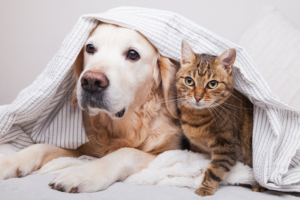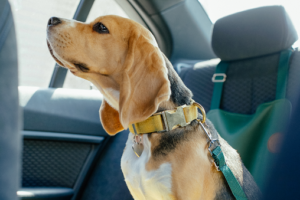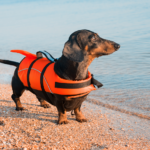Helping Pets have a Safe & Fun Summer
Stacey J. Drubner, JD, LICSW, MPH

EAP Ask the Expert – Rob Halpin, Chief Communications Officer – MSPCA-Angell
Summer is just starting and now is the perfect time to prepare for a safe season for pets. While there are plenty of opportunities for fun, some activities can have risks. The EAP is grateful to partner again with Rob Halpin, who shares some tips from the veterinary experts at the Angell Medical Center*. All the guidance below revolves around two basic principles:

- Know your pet – Make an effort to understand the characteristics that make your pet appropriate for or at-risk in different circumstances
– Breed
– Temperament
– Age
– Health status
– Capabilities
– Likes & dislikes
- Choose safety over comfort or convenience
Activity & Heat Safety

You might think that July or August are the most common months for heat-related illnesses (heat stroke or heat exhaustion). Rob explains that late spring/early summer is when the risk is greatest. In mid-to-late summer, animals tend to be more acclimated to the heat and exercising, and we are probably more careful with our pets when it’s extremely hot. Now is when many well-meaning pet owners start exercising their dogs, often without easing them into an increased activity level. Like most of us, dogs have been sitting on the couch watching Netflix and aren’t prepared for long or intense workouts.
Remember that animals don’t always process heat as easily as humans do. Here are some tips for minimizing the impacts of exercise and/or heat:
What activity type & level makes sense for your Dog?
- Ask yourself “what is the inherent activity level of my dog?” Some dogs (retrievers and herding dogs) are naturally more active. They love walking, playing, and running. Others, such as brachycephalic breeds (shih tzus, pugs, french bull dogs) with flatter, shorter snouts are going to be less active generally and certainly in warmer temperatures. They are not equipped for vigorous exercise and don’t enjoy it. Here is some guidance on dogs and exercise:
- Increase speed and distance gradually
- Always have fresh water available
- Provide opportunities for shade
- Exerciser early or late when the sun is less strong
- Stay close to home
Water Safety
Although not a heat risk, water activities require attention to safety as well.
- Monitor dogs while swimming in pools or at the beach
- As with other activities, allow your dog to build up endurance over time
- If you dog doesn’t like water or has a fear of it, don’t force the issue
-There is a low percentage that this will change
-Our pets’ comfort is more important than our need or ability to make our pets adapt - Some dogs, such as the brachycephalic breeds cannot and should not swim at all
- Be aware of the symptoms of ear issues (common with dogs who swim)
– Head shaking
– Touching the ear with paws
– Redness
- All dogs should wear appropriate fitting life jackets on boats
Never leave a dog in the car, for any reason
- Dogs are better off at home
- Even with moderate temperatures, on a sunny day, the car can reach dangerous levels for a dog within 10 minutes
- Heat exposure can become fatal very quickly
– It’s often the case that dogs can’t be saved when they have severe heat stroke, regardless of access to skilled medical care
A Commonwealth of Massachusetts Good Samaritan Law allows anyone to take action to help a pet in a car.
Inside the home
- Animals are intuitive about how to stay cool. If they go to certain place (bathroom floor for example), it’s probably for a good reason. Try to accommodate these decisions
- If you don’t have AC, consider a floor fan, or air flow via opened windows
Know the warning signs of heat-related illnesses
- Lethargy
- Refusing to walk or sitting down
- Not being compliant (if this is not typical stubborn behavior)
- Shaking or having convulsions
- Frothing at the mouth
Responding to heat reactions
- Return home or find a cool space
- Put the dog in a tepid tub or lake/pond, if nearby
- Offer water
- Seek Immediate vet care with shaking or frothing at the mouth, which indicate heat stroke
Fleas, Ticks, and Heartworm

Although there are risks all year long, the warmer months offer more opportunities for fleas, ticks and heartworm to harm our animals. Relatively affordable, effective, and easy prevention, via collars or medications (topical or oral) are the best way to avoid health consequences. While some impacts are a nuisance (itching and allergies), other side effects can make our pets quite sick and can be fatal. Even if treatment is possible, the interventions are often painful, expensive, and disruptive to the pet and family.
- Fleas (in addition to itching) can cause significant allergic reactions
- Tick-borne illnesses can lead to Lyme Disease, kidney failure and respiratory impacts, just to name a few
- Heartworm can damage organs
Some pets experience side effects from the preventative medications. Although these are relatively rare, you should discuss any concerns you have with your vet.
If paying for medications or vet care is challenging for your family, visit the pet financial resources section on our website.
Allergies and Environmental Exposures
Allergies
Allergies are common. Rob indicates that Angell Medical Center sees more allergic reactions to fleas and ticks than to seasonal culprits like grass or trees. Mites in every variety cause significant allergy issues in cats and dogs. They often manifest on the skin as a hot spot (a red or inflamed skin patch). It’s best to consult with your vet to determine the cause (environmental, food, insects) and treatment for allergies.

Toxic Foods
Many of us are aware of some of the things (chocolate, grapes, onions, sugarless gum, chicken bones) that are harmful to dogs. We should also consider the less obvious but serious risks related to the lengths dogs will go to access things (empty corn cobs/holders, skewers, gravel beneath the grill) they think are food. Angell sees these types of cases quite often and they can harm the intestinal system.
- Educate yourself on known animal toxins
- Do a scan of the surroundings. What might a dog eat if it smells or tastes like food?
- If you can’t monitor your dog near potential risks, it might be best to keep your dog inside
- When in doubt, consult your vet or call poison control (fees may apply)
Drugs
With more time outside, there is the possibility that pets can more easily access improperly disposed substances. Of course, they may also find them inside.
- Marijuana – Angell sees approximately 5-20 animals for marijuana exposure daily. Edibles are extremely attractive because they taste good. While intervention (such as administering fluids) is not necessary in every case, expert observation is advisable
- Opioids – Angell does not treat many pets with fentanyl exposure and it’s likely that opioids are manufactured in a way that makes them unappealing to dogs. However, it’s still helpful to be aware that many illegal substances contain fentanyl, which is deadly to humans and pets. Narcan can be used on pets as well as humans
- Warning signs of drug reaction include sleepiness, vomiting, restlessness/agitation, and anxiety and general discomfort
Chemical exposures
Thankfully lawn, garden and pest control options are less toxic than they were historically. Regardless, it’s always advisable to read labels or consult with vendors to ensure that both indoor and outdoor products (fertilizers and pesticides) are safe and pet friendly. In the warmer months, people may leave their garages open more often, so be mindful of chemicals (anti-freeze) being stored in containers that are accessible and attractive to pets.
Fireworks and Other Loud Noises

Summer brings a whole host of loud noises (thunder, fireworks) that can scare pets and lead to anxiety and discomfort. Pets may seem inconsolable. Behaviorists at Angell recommend the following interventions to minimize the negative impacts and related bad outcomes:
- For dogs
– Keep your dog in a small space, and in your company
– Use a mechanism (AC, app, or noise machine) for sound as a buffer
– Fill a Kong with peanut butter. This serves as a distraction and can lead to tying the noise to a positive association over time
– ThunderShirts may work for some dogs
– If none of the above work, you can consult with your vet about medications as a last but rarely needed option
- For cats
– Make sure they have an escape route in the house, even in places where they might not usually have access
– Put supplies (treats, water, blanket) in their safe space to make it comfortable. Rob, who is a proud cat owner cautions about making it so comfortable that the cat wants to remain there forever 😊
- Eliminate the possibility of your pet bolting when startled or scared -this can lead to getting lost or being hurt by cars, wild animals, or the elements
– Secure windows and screens
– Keep your dog on a leash when outside
– Make sure your pet always has an ID and is microchipped. This can make finding and returning your pet easier and less stressful
Car trips

Summer usually means more travel and it’s important to pay attention to how your pets fare in the car. Some love car rides, but others would rather walk over hot coals than get into a car. Here are some ideas to make car trips safe and enjoyable for all involved.
- As emphasized above, never leave a dog in the car
- All dogs should be secured, preferably with a seatbelt. It’s good to start this at a young age so it feels normal and comfortable
- For longer trips, have food and water, and make frequent rest stops
- Watch for signs of motion sickness or anxiety
– Panting
– Salivating
– Frothing at the mouth
– Vomiting - Here are some tips to address car sickness or fears related to the car
-Talk to your vet if expert advice or medication is needed
Dog Parks and Other Interactions
In winter there tends to be less interaction for people and dogs. Once things start to warm up, so does our inclination to be social. That doesn’t mean our dogs or other people’s dogs feel the same way. Consider the following when you and your dog have meet-ups:
- Know your dog -how do they typically respond to humans (big and small), dogs and crowds
- Watch for threats. Develop situational instincts. Rob calls this “reading the dog park.” Take note of:
– Number of dogs
– Size of dogs
– Spay or neuter status -this is especially important with male dogs
– Posture – open/flexible/wagging or rigid/hair standing up
– Owner awareness or vigilance
- Don’t be reluctant to introduce yourself to people and learn about their dogs
- Introduce your dog to people and other dogs slowly
About the MSPCA-Angell
The MSPCA-Angell is a national and international leader in animal protection and veterinary medicine. They provide direct, hands-on care for thousands of animals each year. Founded in 1868, the MSPCA-Angell is the second-oldest humane society in the United States. The MSPCA comprises Animal Care and Adoption Centers, Law Enforcement and Angell Animal Medical Center.
Help from the EAP
The EAP offers free and confidential services for employees and immediate household family members. EAP records are separate from medical and HR records. Contact the EAP at 866-724-4327 or request an appointment via our online form for confidential assistance. In-person appointments are available at the following locations. Phone or Video (Zoom) appointments are available from all locations.
Other EAP Safety Features
- Personal Safety for Women: Self-defense Goes Way Beyond the Physical
- Stay a Step Ahead of the Predators and Avoid being a Victim of Fraud
*This article provides general guidance but is not a substitute for veterinary care. Always consult your vet with any concerns you have about caring for your pet.







